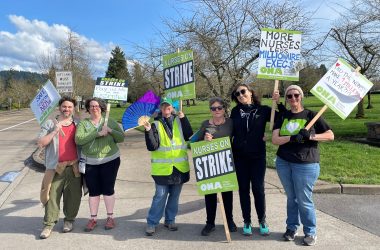
SPRINGFIELD – It’s been an especially busy couple of weeks at the Springfield Police Department: the Thurston protest investigation assessment was released and the police chief has been placed on leave amid an investigation.
The City of Springfield launched an investigation of police chief Rick Lewis, and he was placed on paid administrative leave this week, city manager Nancy Newton said in an email addressed to the jail and police staff on Monday.
“In order to protect the integrity of the investigation, I have decided to place chief Rick Lewis on paid administrative leave while this review is pending,” said Newton, who is the police chief’s supervisor.
Details around the leave are sparse as the City conducts the administrative personnel investigation. “We want to protect the integrity of the investigation and cannot offer additional information about the nature of the investigation at this time,” city spokesperson Amber Fossen said on Tuesday.
Lewis began working with the SPD in 1982 as a reserve officer. He was promoted to captain in 2000, acting chief in 2016, and then chief in 2017.
In the absence of Lewis, lieutenant Matt Neiwert will be acting in capacity. Neiwert began his career with the Lane County Sheriff’s Office working in the jail. He has worked at the SPD for over 21 years.
Five days before chief Lewis was placed on leave, use-of-force expert Rick Braziel presented his findings to the City after completing his investigation of the Thurston protest on July 29, 2020.
Braziel on March 25 released his independent assessment into the Thurston protest, in which Springfield police officers used force to stop demonstrators from marching toward Main Street. Events escalated and led to an unlawful assembly order, a civil disturbance, use-of-force by police, assaults between the protest groups and 14 arrests.
Newton commissioned Braziel to conduct the independent investigation in October 2020. The assessment includes an analysis of crime reports, statements, evidence, video, audio, applicable policies and community input.
While Braziel made 38 recommendations focused on command and coordination; planning and preparation; mental health and wellness; communications; after-action review; and use-of-force, he did not find specific wrongdoing, malice or collaboration with counter-protesters.
“Through this assessment, we’ve received practical and tangible steps for where we can improve in our response to dynamic community events,” Newton said.
THAT NIGHT’S EVENTS
The police department had responded to eight protests between June 6 and July 29, 2020 and two following the July 29 protest. “While the department managed the eight prior 2020 demonstrations reasonably well, the July 29 protests tested the department’s ability to change tactics and strategies,” the report states.
According to the report:
At the center of this analysis is the use-of-force at South 67th and Dogwood streets, where police placed barricades to prevent the march from going toward Main Street.
This protest was centered on a residence in Thurston, in which the homeowner had hung a skeleton from a noose in the front yard. Some community members reported that the skeleton was used as a Halloween prop, but others were offended by the symbol and demanded its removal.
Prior to the protest, SPD leadership said its goal was to facilitate the free flow of pedestrian traffic and allow the marchers to self-direct where they wanted to go, except they would not be allowed to march onto Main Street due to the number of lanes and speeds.
After protest leader Tyshawn Ford led the group through the barricade, officer Bronson Durrant grabbed Ford to arrest him. The crowd pulled Ford back toward the protesters in an attempt to free him and additional police jumped in to assist in the arrest.
Some protesters tried to step away, and some resisted, kicking, hitting, and biting officer Durrant. This struggle continued for nearly three minutes with officers using their hands, fists, tasers and batons to push the crowd away from Durrant and take others into custody who were resisting.
After four arrests were made, officers dragged Ford behind police lines. Ford was kicking officers as he tried to stand while they pulled him along the ground, and officer Durrant struck Ford twice – once on the upper left arm and once on the left side with the side of his closed fist. Another lieutenant then used his body to partially kneel and lie across Ford to control his lower body movements. Officer Durrant used his weight to leverage Ford onto his side and punched Ford on the side of his head.
In another instance at the same location, a woman yelled at the officers and grabbed the baton of an officer trying to push her back. The officer was holding the baton with both hands and released his hand and hit the woman in the face with a closed fist. She released her hold and fell to the ground, leaving the area with blood around her nose and mouth.
“The events surrounding the uses-of-force appeared to be fast and chaotic. However, the events leading up to the use of force were slow to develop and provided opportunities for SPD to adjust response strategies,” Braziel noted. The information considered during this review indicates that the SPD’s use-of-force and de-escalation methods “require attention to bring them within the standard of care in policing,” notably around fluctuating command responsibility, and decision-making hierarchy.
The incident commander, in this case, was chief Lewis. The incident commander is responsible for the entire event, but according to interviewees other commanders took the leadership role, assumed command responsibilities, and were active in crowd management and arrests. Doing so removed SPD’s ability to manage the larger incident and prevented SPD from having a comprehensive situational awareness of the entire protest.
Baziel recommends that the chief of police should not be the incident commander for crowd management events because the ability to independently review uses of force and other complaints is compromised. The chief’s role is broader than commanding the incident, and should ensure the department is performing at the highest levels, keep the city manager informed, motivate employees, and if needed manage relationships that are outside the responsibilities of the incident commander.
Some other recommendations include:
g Better planning and preparation. Many of the officers assigned to the July 29 demonstration were not adequately trained or equipped for this type of event.
g All SPD employees used in non-covert assignments should be clearly identifiable as police to reduce misidentification and speculation.
g Coordinate and work with regional partners, such as Lane County law enforcement agencies to establish a regional crowd management response team.
g Do not ignore victims or delay arrests for crimes committed unless the arrest places people at additional risk. Strategies may include more staff to take crime reports from victims at the scene, undercover officers who can shadow suspects or drones that can monitor activities and locations.
g Develop protocols for restricting access behind police barricades while also allowing people with legitimate reasons to pass through.
g Consider different types or use of barricades for crowd management.
g Find ways to better separate protesters from counter-protesters.
In May, the SPD will begin implementation of body-worn cameras to its officers, lieutenant George Crolly announced in a release on Tuesday, which was another recommendation made by Braziel.
The body-worn camera (BWC) project team has been meeting weekly since June 2020 with a focus on implementing body cameras and in-car video. The goal, Crolly said, is to provide more information for investigations, increase accountability and demonstrate effort toward public transparency.
On March 1, SPD was awarded a $120,000 grant to implement the cameras. “This technology is an opportunity to showcase and enhance the department’s commitment to transparency while further strengthening the level of trust that exists between the men and women of the Springfield Police Department and our community,” Crolly said.
“The City is committed to learning and improving from this experience,” said mayor Sean VanGordon. “Our growth is possible thanks to the many community members who participated in this assessment and offered their voice so that we can pause, reflect, and implement change.”
Read the full assessment report online at tinyurl.com/thurstoninvestigation






